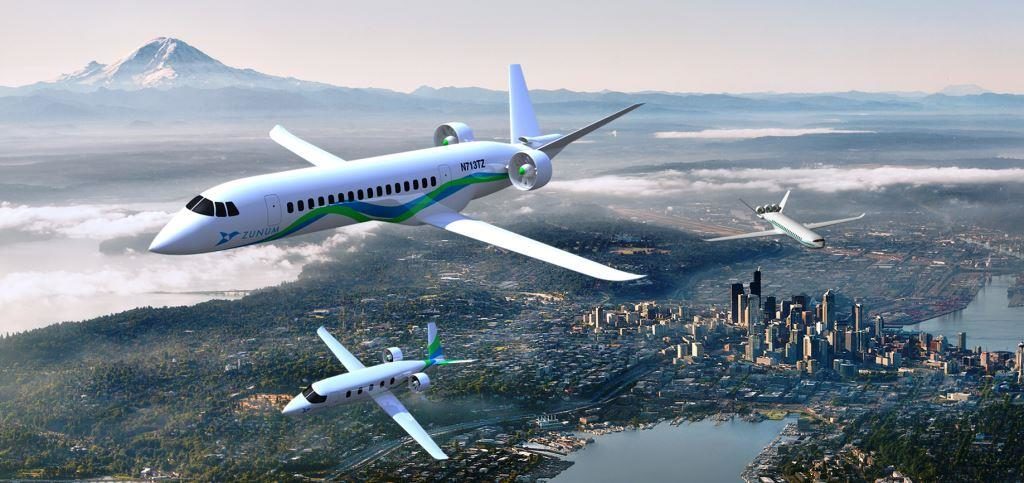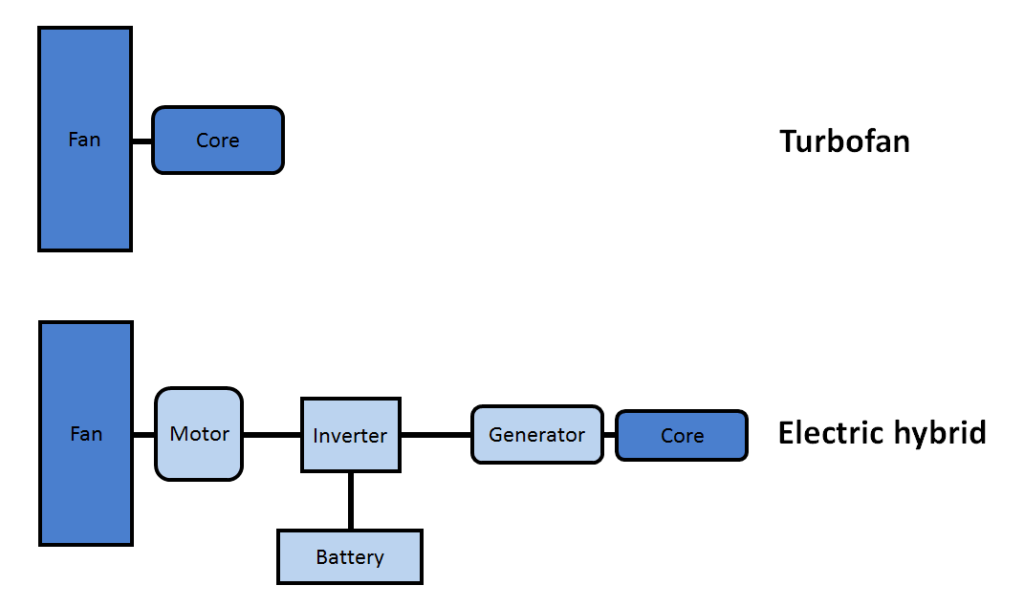Leeham News and Analysis
There's more to real news than a news release.
 Leeham News and Analysis
Leeham News and Analysis
- Bjorn’s Corner: New engine development. Part 4. Propulsive efficiency April 19, 2024
- Boeing unlikely to meet FAA’s 90-day deadline for new safety program April 18, 2024
- Focus on quality not slowing innovation, says GKN April 18, 2024
- Boeing defends 787, 777 against whistleblower charges April 17, 2024
- Dissecting Boeing CEO’s statement next new airplane will cost $50bn April 15, 2024
Bjorn’s Corner: Electric aircraft, Part 4
July 21, 2017, ©. Leeham Co: In this Corner, we will start looking at the mass of the different components in a hybrid electric propulsion system compared with a classical turbofan propulsion.
Our propulsion project is for a regional airliner with 50 seats. The segment marked the start of the regional airliner with Bombardier’s CRJ-200 and Embraer’s ERJ-145. Today, the segment is more and more flown with Turboprops like ATR42-500.

Figure 1. Zunum aero regional airliners and a NASA boundary layer ingestion airliner. Source: Zunum aero.
Weight of a hybrid chain
We will develop the different masses for the components in a hybrid propulsion chain and compare these to the mass of a normal turbofan propulsion system. The components are those in Figure 2.
Fan modules
We will assume the fan modules will have the same total mass irrespective if they are divided in two or four units for the aircraft. For a regional airliner of 50 seats, the fan modules on the aircraft’s turbofans weigh about 180kg each.
Turbofan mass
A modern high-pressure turbofan core for this size airliner will have a mass of around 570kg. In total, the turbofan will have a mass of 750kg and the propulsion unit (turbofan with nacelle and pylon) 1,050kg.
The propulsive power at takeoff is 40kN (9,000lbf) per engine. The shaft input to the fan, from the core, will be 7,000kW at takeoff and 3,000kW at cruise.
Hybrid chain mass
To propel our airliner at the dimensioning take-off case, where one propulsion unit is inoperative, we need the same V2 safety speed power from three propulsion units as one of the turbofans, i.e. 7000kW. It means we need 2,333kW per motor driving the fans. Our take-off power is then 4*2333kW=9,332kW instead of 14,000kW for the turbofan case.
Electric superconducting motors for driving fans will have a special build. Fan modules, whether for turbofans or electric propulsors, create large gyroscopic forces. Therefore, a motor with a bearing holding the fan is heavier than the equivalent generator.
The specific mass for such motors is ~5kW/kg, whereas the generator is a bit higher at ~8kW/kg.
The four 2,332kW motors would then have a mass of 467kg each. Add a fan unit mass of 90kg and then put it all in a nacelle and on a pylon. In total our propulsors (with nacelles, fans, motors and pylons) will have a mass of 700kg each.
If we now put together our hybrid chain’s propulsor units, we have 4*700kg=2800kg. This is 33% more than our two turbofan propulsive units. We have still not counted the gasturbine core and its generator yet. Nor have we counted the battery or control electronics.
Next corner
We will add these units in our next Corner and see where we land. We will also discuss whether our hybrid architecture might bring us some gains in the sizing of the components.
Related
Category: Bjorn's Corner, Bombardier, Embraer
Tags: ATR 42, Bombardier, CRJ-200, Embraer, ERJ-145
7 Comments on “Bjorn’s Corner: Electric aircraft, Part 4”
Leave a Reply Cancel reply
Email Subscription
Twitter Updates
My TweetsAssociations
Aviation News-Commercial
Commentaries
Companies-Defense
Resources
YouTube
Archives
- April 2024
- March 2024
- February 2024
- January 2024
- December 2023
- November 2023
- October 2023
- September 2023
- August 2023
- July 2023
- June 2023
- May 2023
- April 2023
- March 2023
- February 2023
- January 2023
- December 2022
- November 2022
- October 2022
- September 2022
- August 2022
- July 2022
- June 2022
- May 2022
- April 2022
- March 2022
- February 2022
- January 2022
- December 2021
- November 2021
- October 2021
- September 2021
- August 2021
- July 2021
- June 2021
- May 2021
- April 2021
- March 2021
- February 2021
- January 2021
- December 2020
- November 2020
- October 2020
- September 2020
- August 2020
- July 2020
- June 2020
- May 2020
- April 2020
- March 2020
- February 2020
- January 2020
- December 2019
- November 2019
- October 2019
- September 2019
- August 2019
- July 2019
- June 2019
- May 2019
- April 2019
- March 2019
- February 2019
- January 2019
- December 2018
- November 2018
- October 2018
- September 2018
- August 2018
- July 2018
- June 2018
- May 2018
- April 2018
- March 2018
- February 2018
- January 2018
- December 2017
- November 2017
- October 2017
- September 2017
- August 2017
- July 2017
- June 2017
- May 2017
- April 2017
- March 2017
- February 2017
- January 2017
- December 2016
- November 2016
- October 2016
- September 2016
- August 2016
- July 2016
- June 2016
- May 2016
- April 2016
- March 2016
- February 2016
- January 2016
- December 2015
- November 2015
- October 2015
- September 2015
- August 2015
- July 2015
- June 2015
- May 2015
- April 2015
- March 2015
- February 2015
- January 2015
- December 2014
- November 2014
- October 2014
- September 2014
- August 2014
- July 2014
- June 2014
- May 2014
- April 2014
- March 2014
- February 2014
- January 2014
- December 2013
- November 2013
- October 2013
- September 2013
- August 2013
- July 2013
- June 2013
- May 2013
- April 2013
- March 2013
- February 2013
- January 2013
- December 2012
- November 2012
- October 2012
- September 2012
- August 2012
- July 2012
- June 2012
- May 2012
- April 2012
- March 2012
- February 2012
- January 2012
- December 2011
- November 2011
- October 2011
- September 2011
- August 2011
- July 2011
- June 2011
- May 2011
- April 2011
- March 2011
- February 2011
- January 2011
- December 2010
- November 2010
- October 2010
- September 2010
- August 2010
- July 2010
- June 2010
- May 2010
- April 2010
- March 2010
- February 2010
- January 2010
- December 2009
- November 2009
- October 2009
- September 2009
- August 2009
- July 2009
- June 2009
- May 2009
- April 2009
- March 2009
- February 2009
- January 2009
- December 2008
- November 2008
- October 2008
- September 2008
- August 2008
- July 2008
- June 2008
- May 2008
- April 2008
- March 2008
- February 2008




If you’ve got four independent propulsion units, surely you won’t need 14000kW of power at take-off?
A twin engine vehicle does, because if one engine fails then the other has to do the job itself. In other words the vehicle has to have at least two times as much power as it will ever need. A four engine vehicle should have only 4/3 as much power as it will ever need.
I calculate that the four engine vehicle will require only 9333kW at take-off, to cover a single failure. This changes the maths.
Thanks Chris. My bad.
I have changed the article too reflect that you only need half the turbofan power at V2, the safety speed, and that this is now shared between three of the four hybrid propulsion units.
This was the reason for us to go to four propulsors in the first place.
With a set of 4 energy sources and sinks you can
also cross connect at the intermediate DC buslevel.
i.e. you can loose one generator or propulsor with less impact than loosing a complete engine.
Hi Bjorn, you are teasing me, I’m dying to see the conclusion😐
After you finish this series, can you write about open rotors/propfans?
Yes Bjorn, doing open rotors/propfans would be GREAT. I worked on the them when I worked at Pratt & Whitney sooo many years ago
Cascadian and Joel,
we will cross over to higher bypass (lower specific thrust) solutions (propfan/open rotor and propeller) as we will see that the electric propulsion is not really suited to step in at the speed range of a regional jet. Just follow the series.